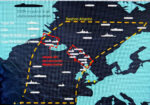In a high-profile show of force aimed at reinforcing U.S. defense commitments in the Western Hemisphere, a U.S. Air Force B-52H Stratofortress bomber and U.S. Marine Corps F-35B Lightning II aircraft conducted a coordinated joint strike demonstration near Venezuelan airspace in early October 2025. The operation underscores Washington’s ability to project long-range precision firepower from both strategic bombers and forward-deployed stealth fighters in contested environments.
Strategic Context: Signaling Amid Regional Tensions
The joint demonstration occurred amid heightened tensions between the United States and the Maduro regime in Venezuela, which has deepened military ties with Russia and Iran over the past year. According to U.S. Southern Command (SOUTHCOM), the exercise was designed to reassure regional allies such as Colombia and Guyana while deterring potential aggression or coercion from Caracas.
While not explicitly named by Pentagon officials, the timing of the operation closely follows Venezuelan military exercises along its border with Guyana—where territorial disputes over the oil-rich Essequibo region have escalated—and reports of Iranian drone technology transfers to Venezuelan forces.
Rear Admiral James Aiken, commander of U.S. Naval Forces Southern Command/U.S. Fourth Fleet, emphasized that “the ability to integrate long-range strategic bombers with fifth-generation fighters from sea-based platforms sends a clear message about our commitment to hemispheric security.”
Operational Details: B-52H Bomber Links with F-35Bs from USS Wasp
The exercise involved a USAF B-52H Stratofortress from Minot Air Force Base operating under Global Strike Command (AFGSC), which flew into SOUTHCOM’s area of responsibility as part of a Bomber Task Force (BTF) deployment. The bomber linked up with two USMC F-35Bs deployed aboard USS Wasp (LHD 1), an amphibious assault ship currently operating in the Caribbean Sea.
The integration showcased multi-domain coordination across air and maritime platforms using Link 16 tactical data links for real-time targeting updates. The aircraft simulated coordinated strikes on maritime targets using Joint Direct Attack Munitions (JDAMs) and AGM-158 Joint Air-to-Surface Standoff Missiles (JASSM), although no live munitions were expended.
- Bomber: B-52H Stratofortress – range >14,000 km unrefueled; payload up to 31,500 kg
- Fighter: F-35B Lightning II – STOVL variant; stealthy ISR/strike role; carrier-capable
- Ship: USS Wasp (LHD 1) – can carry up to six F-35Bs plus MV-22s and rotary assets
- Munitions simulated: JDAMs (GPS-guided bombs), JASSM (stealth cruise missile)
Tactical Implications for A2/AD Environments
This type of integrated strike rehearsal is particularly relevant for penetrating anti-access/area denial (A2/AD) zones—a growing concern given Venezuela’s acquisition of Russian-made S-300VM surface-to-air missile systems and Iranian-supplied radar upgrades.
The pairing of high-altitude standoff platforms like the B-52 with low-observable assets like the F-35B enables layered targeting strategies that can degrade enemy IADS through suppression or decoy tactics before delivering precision effects on key nodes such as command centers or radar arrays.
This mirrors Pacific theater concepts like Agile Combat Employment (ACE) but adapted for littoral operations in Latin America—leveraging distributed basing aboard amphibious ships rather than fixed airfields vulnerable to preemptive strikes.
Force Projection Without Escalation
Pentagon officials were careful to frame the operation as defensive signaling rather than provocation. No aircraft entered Venezuelan sovereign airspace during the drill, which was conducted entirely within international airspace over international waters under full FAA coordination.
This approach reflects broader U.S. doctrine on “conventional prompt global strike” capabilities—demonstrating credible reach without triggering escalation thresholds associated with nuclear posturing or territorial incursions.
The use of legacy bombers like the B-52—now upgraded with new radar systems and digital avionics—alongside cutting-edge stealth fighters also illustrates how legacy platforms remain relevant when networked into modern C4ISR architectures.
SOUTHCOM’s Expanding Role in Integrated Deterrence
SOUTHCOM has increasingly emphasized integrated deterrence through joint exercises involving multiple services and partner nations across Latin America and the Caribbean. In recent months it has hosted counter-narcotics ISR drills using MQ-9 Reapers alongside Colombian forces, naval patrols near Panama Canal chokepoints, and cyber defense exchanges with Brazil’s armed forces.
This latest bomber-fighter integration marks one of SOUTHCOM’s most visible applications yet of high-end conventional deterrent capabilities typically reserved for Indo-Pacific or European theaters.
“We are demonstrating that strategic reach is not limited by geography,” said Gen. Laura Richardson, SOUTHCOM commander. “Whether it’s Caracas or Kyiv—we will be where we need to be.”










